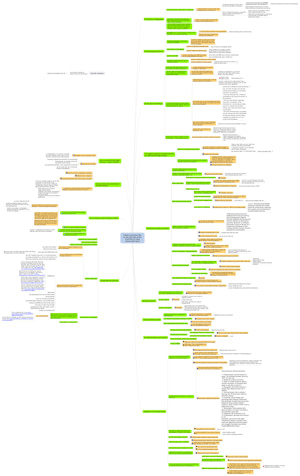What is action mapping?
Action mapping is a streamlined process to design training in the business world. Its goal is to help designers:
- Commit to measurably improving the performance of the business
- Identify the best solution to the performance problem
- When training is necessary, create realistic practice activities, not information presentations
It's a mashup of performance consulting and backward design, with a focus on real-world behaviors rather than assessment questions. I published the first version in May 2008 (here's the first blog post about it).
The following slideshow gives a simplified, very high-level overview. It uses lighthearted stock photos from 2008 of a guy dressed in a ninja outfit. No political statement is intended.
Because I was designing elearning at the time, I presented action mapping as an elearning design model, but it works for all types of business training, as I show in my book.
The addition of a flowchart
In May 2013, I deepened step 2 to include the use of a flowchart that helps identify lean, in-the-workflow solutions, such as job aids or process improvements. Training is rarely the best or only solution to a problem.
Some advantages of action mapping
Action mapping is being used by businesses and governmental organizations around the world. Happy action mappers have told me that the main advantages are:
- The stakeholders "get it" right away -- it's an intuitive process and the benefits are easy to see.
- Subject matter experts who are included in the process are less likely to add extraneous information.
- The resulting training is likely to be rich with scenarios, which learners often prefer over information presentations.
Possible benefits to the field of training design
One of my goals in creating the model was to address some weakness I saw in our profession, including:
- We're not held accountable for what we do because almost nothing we do is measured. As a result, our work isn't seen as vital to the organization. By putting a measurable business goal -- a high-level evaluation -- first and making it the center of everything we do, we publicly commit to improving our organization's performance and demonstrate our value.
- While the concepts of performance consulting and designing for behavior have a long history, I didn't see designers actually using them. By combining them visually I hoped to get them into practice.
- Almost everyone has been taught through a lifetime of traditional schooling that "teaching" means "presenting information." We needed a clear, graphic model to help us see a different approach.
Corrections to some common misunderstandings
Action mapping is increasingly being presented at conferences or taught within big organizations. A few misunderstandings or misrepresentations have come up. Below are some clarifications.
It's a collaborative process -- the designer doesn't create the map on their own. Action mapping works far better if the client and subject matter expert are included from the very beginning. Both should definitely be included when setting the goal, and the SME at least should be included in identifying what people need to do and why they aren't doing it. No designer should create a design in isolation.
You should make sure training is really part of the solution. People were skipping this aspect of step 2, which is why I added the handy flowchart. Action mapping includes needs analysis; it's not just a way to organize content. Unfortunately, some people have presented the system as a way to design activities based on content from the client, skipping the analysis.
Action mapping isn't intended for use in academia. I created action mapping for the corporate world, where it's relatively easy to set a measurable goal and to analyze what people need to do on the job to reach that goal. The process focuses on observable, measurable behaviors, not knowledge, and it assumes that you have people currently doing the job who you can talk to and observe.
It's usually not a super-simple diagram. The map gets as complicated as you need it to get. For example, it's common to list major actions you want people to take on the job and then break them down into sub-action that branch off the major ones. The map shown here is the one I used to design my scenario design course.
It's not a mind map. You don't just add stuff as you think of it. An action map looks like a mind map, but the links between each item create dependencies. Everything on the map has to justify its existence by linking directly to the business goal. The purpose of the map is to prevent the casual adding of content.

Scenario design toolkit
Learn to design scenarios by designing scenarios, on the job. This self-paced toolkit walks you through all the steps, and interactive tools help you make the tricky decisions.
Build your performance consulting skills
Stop being an order taker and help your clients solve the real problem. The Partner from the Start toolkit helps you change how you talk to stakeholders, find the real causes of the problem, and determine what type of training (if any!) will help.
